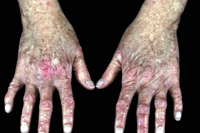
Professor Irwin McLean of the University's Medical School has discovered the gene that causes two inherited skin disorders - a discovery that will allow rapid and highly accurate DNA-based diagnosis.
Professor McLean has discovered the gene that causes Kindler syndrome, a rare genetic condition that causes skin blistering in infancy but also causes premature ageing of the skin. For sufferers of Kindler syndrome this discovery will lead to new therapies to treat the disease.
The Kindler syndrome gene was identified by scanning the entire human genome for a region that was shared by Kindler syndrome patients but was absent in their ‘normal’ relatives. Analysis of the genes in this region resulted in the discovery of a novel gene that makes a new class of protein in the skin. Further analysis showed that the protein, called kindlin-1, contributes to the structure of the skin and explains the blistering in patients. Professor McLean thinks that the same protein is also likely to be involved in cell signalling which might explain the premature ageing symptom. Further research into this new protein may help unravel the normal skin ageing process.

Professor McLean and his team discovered this potentially revolutionary gene as part of an international consortium to identify the cause of Kindler syndrome, which included the Universities of Dundee, California, San Francisco and Professor John McGrath’s group, St Thomas's Hospital, London. The Dundee and London groups are now continuing the project to better understand the function of this new protein in this distressing condition and skin ageing in general.
The second discovery is the identification of the gene that causes laryngo-onycho-cutaneous (LOC) syndrome - a rare genetic condition quite commonly suffered by Pakistanis.
The syndrome is characterised by abnormal wound healing in the skin and other tissues including the eye, the larynx and the nails. LOC patients suffer skin lesions that are very slow to heal and can also lead to difficulties in breathing. Usually patients require a permanent tracheotomy by age ten.
By scanning the human genome map, Irwin and his team identified a region shared by all LOC patients that was absent in their unaffected relatives.
The gene, called laminin alpha-3 is a gene that is already known but the team discovered that it is twice its previously reported size and makes three distinct proteins laminin alpha-3a, alpha 3b1 and alpha 3b2. The defect within this gene in LOC patients affects only a small part of one of these proteins (alpha 3a) and the defect itself represents a completely novel genetic mechanism explaining the rarity of the condition outside the Pakistani population.
The Dundee group is going on to study these mechanisms in more detail, with the aim of developing therapies for LOC syndrome and importantly other conditions including venous leg ulcers and rheumatoid arthritis.